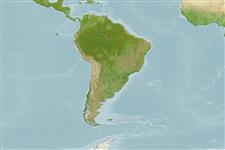Common names from other countries
Environment: milieu / climate zone / depth range / distribution range
Ekologi
marina; djupintervall 15 - 120 m (Ref. 31416). Temperate; 34°S - 48°S, 78°W - 68°W (Ref. 75154)
Circumglobal, southern seas.
Length at first maturity / Size / Vikt / Age
Maturity: Lm 36.9 range ? - ? cm
Max length : 47.0 cm SL hane/ej könsbestämd; (Ref. 31416)
Life cycle and mating behavior
Maturities | Reproduktion | Spawnings | Egg(s) | Fecundities | Larver
Pavlov, Y.P., 1991. Brama australis Valenciennes - a valid species of sea bream (Bramidae) from the southeastern Pacific Ocean. J. Ichthyol. 31(5):6-9. (Ref. 31416)
IUCN Red List Status (Ref. 130435)
CITES (Ref. 128078)
Not Evaluated
Threat to humans
Harmless
Human uses
Fiskeri: kommersiell
Verktyg
Special reports
Download XML
Internet-källor
Estimates based on models
Phylogenetic diversity index (Ref.
82804): PD
50 = 0.5039 [Uniqueness, from 0.5 = low to 2.0 = high].
Bayesian length-weight: a=0.01820 (0.00782 - 0.04232), b=2.96 (2.76 - 3.16), in cm Total Length, based on LWR estimates for this (Sub)family-body shape (Ref.
93245).
Trofisk nivå (Ref.
69278): 4.0 ±0.63 se; based on food items.
Resiliens (Ref.
120179): Mellan, lägsta populationsfördubblingstid 1,4-4,4 år (Preliminary K or Fecundity.).
Prior r = 0.24, 95% CL = 0.16 - 0.35, Based on 1 data-limited stock assessment.
Fishing Vulnerability (Ref.
59153): Moderate vulnerability (43 of 100).
